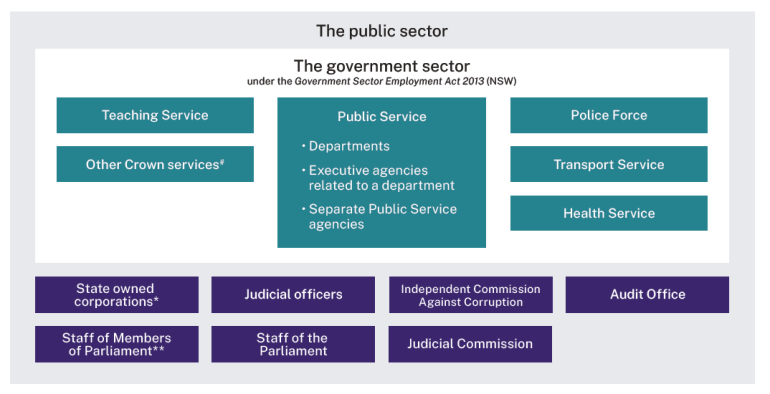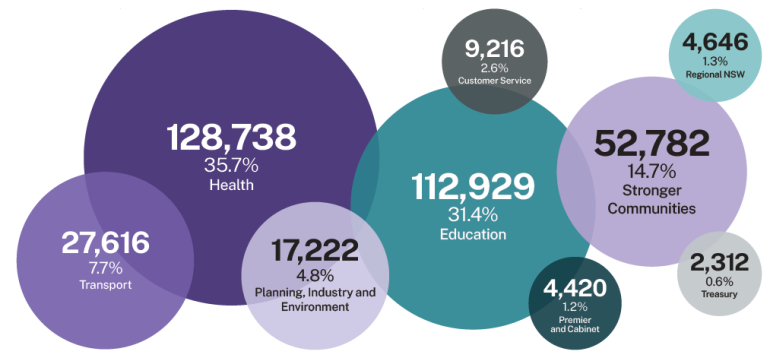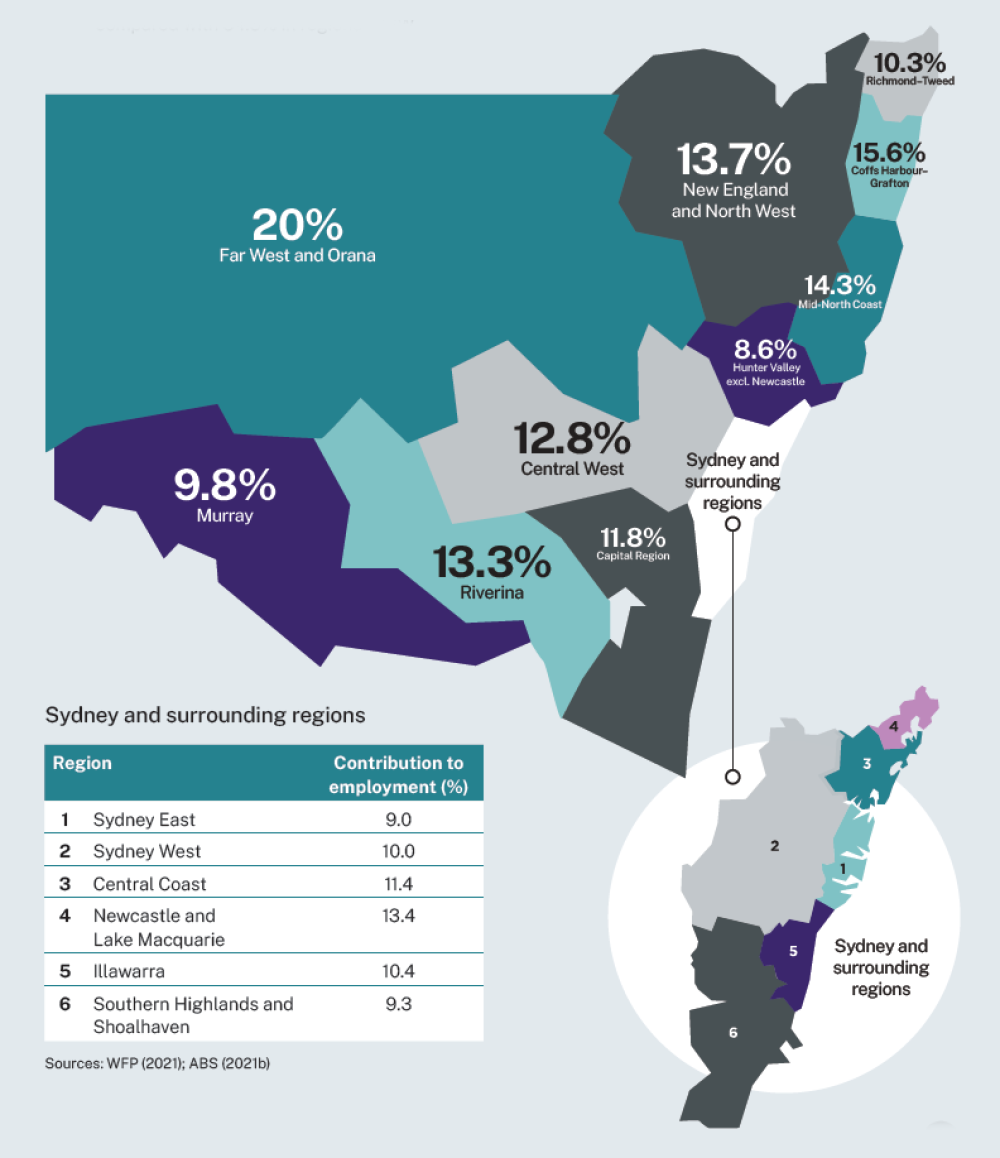Over 400,000 people work in the NSW public sector to deliver a wide range of services to the people of NSW. The sector is divided into nine operational clusters to best coordinate, develop and provide related services and policy. Each cluster oversees the delivery of government services across NSW.
Headcount and full-time equivalent employees
431,350
ongoing, temporary and casual employees
equating to 360,190
full-time equivalent (FTE) employees
Source: Workforce Profile (WFP) (2020, 2021), census period
The number of FTE employees in the sector increased by 11,682 (or 3.4%) from 2020 to 2021, to support service delivery and drive the recovery from bushfires, floods and the COVID-19 pandemic.
The size of the sector increased by 10,721 FTE (or 3.2%) from 2019 to 2020, to support service delivery and address the impacts of bushfires and the COVID-19 pandemic.
Source: WFP (2012–21), census period
The sector grew strongly in 2021, but this growth was outpaced by growth in the number of NSW employed persons (up 5.4%), which was the fastest in five years.
The sector also grew relative to the number of NSW employed persons, which contracted for the first time in five years.
Sources: WFP (2016–21), ABS (2020a)
Structure of the NSW public sector
The GSE Act establishes two main employment groups: the government sector, and the Public Service within it. Most government employees are in the government sector.
The sector is also organised in clusters. The term ‘cluster’ is commonly used for administrative purposes; however, clusters are not established by legislation. The public sector is structured into nine operational clusters, each led by a Secretary, to coordinate related day-to-day public services.

The public sector covers the government sector (under the Government Sector Employment Act 2013 (NSW) (GSE Act)), which includes six areas: the Teaching Service, Other Crown services#, the Public Service (including departments, executive agencies related to departments and separate Public Service agencies), the Police Force, the Transport Service and the Health Service.
Also under the umbrella of the public sector, but outside the government sector, are seven areas: State owned corporations*, Staff of Members of Parliament**, Judicial officers, Staff of the Parliament, the Independent Commission Against Corruption, the Judicial Commission and the Audit Office.
# Examples of other Crown services include the TAFE Commission, School Administrative and Support Staff, and Sydney Trains.
* Under the GSE Act, State owned corporations are included in the government sector for certain specified purposes. In this report, they are treated as part of the public sector but not the government sector.
** The PSC does not collect data on these employees.
Under the GSE Act, NSW universities are part of the government sector for certain specified purposes. The PSC does not collect data on the employees of NSW universities. They are not considered part of the public sector or government sector in this report.

| Cluster | FTE | % |
|---|---|---|
| Health | 128,738 | 35.7 |
| Education | 112,929 | 31.4 |
| Stronger Communities | 52,782 | 14.7 |
| Transport | 27,616 | 7.7 |
| Planning, Industry and Environment | 17,222 | 4.8 |
| Customer Service | 9,216 | 2.6 |
| Regional NSW | 4,646 | 1.3 |
| Premier and Cabinet | 4,420 | 1.2 |
| Treasury | 2,312 | 0.6 |
Source: WFP (2021), census period
Note: Percentages indicate the contribution of the cluster FTE to total public sector FTE.
Headcount and contribution to overall employment by NSW region
The NSW Government is a significant employer in every part of the state. Most public sector employees work in Sydney (59.1%). However, the sector contributes relatively more to overall employment in regional areas of NSW than it does to employment in Sydney.
In 2021, 65.7% of public sector employees worked in a metropolitan area (Sydney, Newcastle and Wollongong), compared with 34.3% in regional NSW.

Greater NSW
| Region | Contribution to employment (%) |
|---|---|
| Hunter Valley excl. Newcastle | 8.6 |
| Mid-North Coast | 14.3 |
| New England and North West | 13.7 |
| Far West and Orana | 20.0 |
| Coffs Harbour – Grafton | 15.8 |
| Richmond – Tweed | 10.3 |
| Capital Region | 11.8 |
| Riverina | 13.3 |
| Murray | 9.8 |
| Central West | 12.8 |
Sydney region
| Region | Contribution to employment (%) |
|---|---|
| Sydney East | 9.0 |
| Sydney West | 10.0 |
| Central Coast | 11.4 |
| Newcastle and Lake Macquarie | 13.4 |
| Illawarra | 10.4 |
| Southern Highlands and Shoalhaven | 9.3 |
Sources: WFP (2021); ABS (2021b)
Case study: NSW Government Regionalisation Strategy
The NSW Government launched a principles-based regionalisation policy to increase the number of public sector roles outside metropolitan areas. Find out how the strategy was developed and the outcomes all clusters are working towards.
Occupations
The NSW public sector employs people in a wide range of occupations.
70,270 School Teachers
up from 69,330 in 2020
51,411 Nurses
up from 49,602 in 2020
17,174 Police Officers
up from 16,786 in 2020
47,406 Clerical and Administrative Workers
up from 46,227 in 2020
25,802 School Support Staff
up from 24,726 in 2020
13,190 Medical Practitioners
up from 12,847 in 2020
7,886 Social and Welfare Professionals
up from 7,722 in 2020
5,220 Cleaners and Laundry Workers
down from 5,268 in 2020
4,745 Ambulance Officers
up from 4,649 in 2020
4,605 Labourers
up from 4,352 in 2020
4,297 Prison Officers
up from 4,016 in 2020
4,157 Firefighters
up from 3,987 in 2020
2,665 Bus Drivers
down from 2,765 in 2020
2,074 Train Drivers
up from 2,007 in 2020
1,988 Food Preparation Assistants
down from 2,024 in 2020
Source: WFP (2020, 2021), census period
Employment types
To ensure the sector can flexibly deliver services, the way people are employed varies. Most people are employed on an ongoing basis; however, this proportion has been decreasing over time. The wide variety of roles within the NSW public sector means that our people are employed across a wide remuneration range.
Source: WFP (2012–21), census period
Note: The ‘Other’ category includes employees whose employment category is Contract Executive, Contract Non-Executive, Statutory Appointee, Transport Senior Manager or Other.
Source: WFP (2012, 2017, 2021), census period, non-casual only
Note: To provide a whole-of-sector perspective, remuneration has been aligned with the non‑executive grades defined in the Crown Employees (Administrative and Clerical Officers – Salaries) Award 2007. The GSE Act provides for the Premier to determine the bands in which senior executives are employed. Currently, there are four bands.
- Next section: our people
Who we are and how we feel at work.